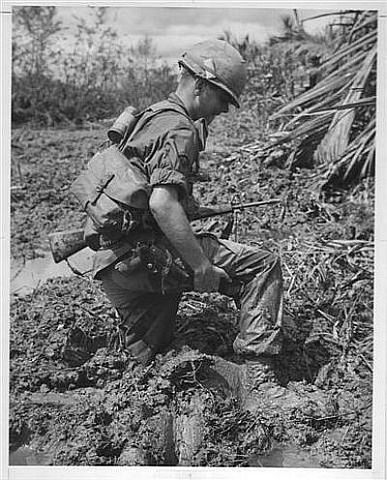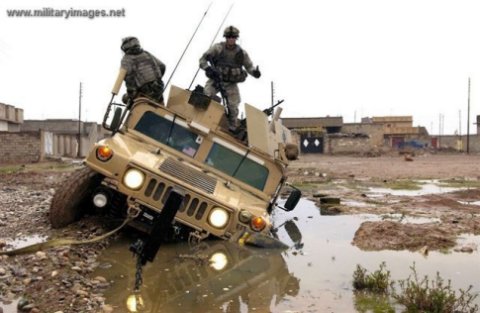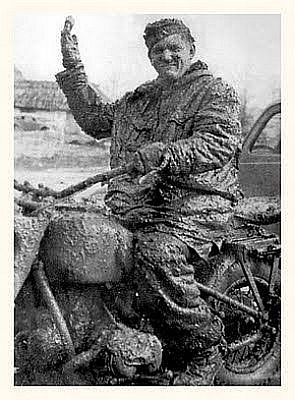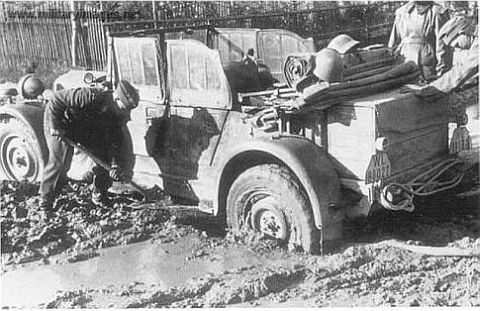

 The South African
The South African
by Ann Bourdin
There are, however, two other kinds of mud: Seasonal mud caused by known weather fronts such as monsoon and the Rasputisa in Russia, and Random mud. We shall mostly be discussing these kinds of mud and their effect, over a hundred years, on movement, machines and men. As you know, I am an ancient historian, and you may wonder why I have ventured so far from my comfort zone.
The reason is quite obvious, really. The ancients did not make war in bad weather. They went into winter quarters, as did the medieval armies and indeed all armies up until the 19th Century. There were occasional encounters with the random mud caused by sudden heavy thunderstorms, witness Agincourt and the Battle of Waterloo, but things changed radically in the 19th Century. What changed?
Well, men invented the steamship and the railway; both of which revolutionised man's relationship to time and distance. There was no longer any need to rely on bad roads which made overland travel so prolonged and uncomfortable; there was no need to rely on the vagaries of wind to make a sea journey. So, with these two inventions, man came to believe that he not only had a mastery of time and distance, but the elements themselves.
He forgot that in the 19th and indeed the 20th Century, armies mostly moved at the rate of marching footsoldiers, as they had always done. Oh, railways and steamships could deliver them nearer to the battlefield, much quicker, but in the end, it was walking and fighting on foot which did the job. Field artillery didn't help, of course. With it you could have the illusion of fighting at a distance, but bombardments are rarely decisive and can often lead to severe miscalculations which the Poor Bloody Infantry has to go in and put right, if they can. And as my other interest is logistics, mud as a limiting factor looms large in my view of events.
Not all wars lend themselves to my narrative, although all of them had their muddy moments. So I shall be dealing with, successively, the American Civil War, (briefly), World Wars I and II, Korea, Vietnam, and a few modem examples. The reasons for my choice are that we had photographers at all of them, so I have lots of images; and they have all been extensively documented, in English, and therefore we know more about them. I earnestly hope that I shall not overrun my time and that there will therefore be opportunities for any old soldiers here who fought in mud, to add their brief comments too.
The first point concerns this man - General Ambrose Burnside, a Union General who decided to steal a march on the enemy, by crossing the Rappahanock into Virginia, and chose his moment badly. The result was the Mud March, so called because a sudden thaw, in January, and four days of unceasing rain, mired men and mules to their bellies and he only managed to advance 1 mile on the first day. On the second day, he issued liquor to encourage the men, but this only resulted in a drunken affray, and on the third day the whole scheme had to be abandoned. Burnside offered to resign and Lincoln accepted, and replaced him with Hooker. However, Burnside is mostly remembered for having given his name to those magnificent whiskers he wears, the sideburns. Burnside was disgraced for something which was not his fault, and nothing was learned.
I am talking about unexpected mud, caused by sudden weather changes and, as such, unpredictable. This mud comes in three kinds - in sandy soil, where it quickly drains and does not stick, that in fine dark soil (black cotton in Africa) which turns the ground to a slurry, reminiscent of gravy, and that in clay - which last is the most important and dangerous to military men. In this type of soil, the water sinks into a heavy soil which has a tendency to clump anyway, and stays there, often for weeks, so that all traffic over such ground churns up and sticks. I grew up in London, which is a clay city, witness so many brick buildings, and I can remember the backbreaking toil to dig our garden. But out of it we grew wonderful potatoes and roses, both of whom love those conditions. For clay never really dries out. Dig enough and you will hit moisture. You will see from the chart that mud comes in several categories, as I have already said and its behaviour governs how difficult it is to operate in.
We shall next look at WWI which was notorious for its muddy conditions. I do not propose to rerun the whole War before you, but simply to highlight some of the conditions which were caused by mud and what attempts were made to deal with it. The Western Front took place in a low-lying area of northern France and Belgium, which needs drainage ditches, called polders, to drain the fields and make them suitable for crops and pasture. These ditches were soon cut by artillery fire and the whole area turned to a morass, which never real1y dried out during the whole four years of the war. As trees were also blasted to smithereens, the root systems which might have held the land together were also destroyed and, because it was a very static war, rarely moving more than a few hundred yards in any direction, the same roads were used again and again and quickly became degraded, indeed destroyed. Conditions at the front were appalling, and even the rotation system which allowed troops to retire for rest, offered little respite, since it was often a foot-slogging tramp for 5 miles, with clay sticking to boots and making them weigh several more pounds than they should. Even when you got back to the rest areas, the persistent rainy weather made them less of a haven than they should have been, but they did offer the opportunity to clean up and change clothes for something dry. In addition to all this, and a less than satisfactory diet, there was always the problem of helping out machinery which had become mired.
But if you couldn't cry, you might as well laugh, and one persistent joke which went the rounds, and again in WWII was of a man losing his helmet in the mud. As he groped around for it, he encountered a face, staring up at him. "What are you doing, there?" he asked and received the reply "You won't believe this but I am on horseback". The problem was compounded by the fact that you are talking about farmland, which is regularly ploughed and this enables it to hold more water than undisturbed land.

There are many horror stories of that war, not least of which are the cases of men who drowned in mud so deep they could not be rescued. I am sure that some of these are urban legends, but there are enough real cases for every old soldier who served on that front to have nightmares for the rest of his life, often about drowning in mud. There are many monuments to the missing in the area, the Menin Gate alone carried 85,000 names, and the reason many were never found is that they indeed lie drowned and buried in all that mud. And every farm in Flanders has, at its gate, a small pile of WWI artefacts ploughed up this season, and they are collected, at the end of every summer.
The funny thing about mud, is that in all military memoirs it gets a mention. Men will ignore heat and cold, dust and wind, but they all have a particular resentment about mud. And overwhelmingly, mud images are those of food. So that it varies from chocolate sauce to blancmange, via molasses and porridge. Here is one soldier who had obviously pondered the problem closely.
Georgia has the red clay kind, slippery when going uphill. Florida's mud is wet and sandy, packs wet and is good for cleaning mess kits. England has soupy mud that doesn't play square. If you are on a brick walk, at some point where bricks come together, you'll cause a geyser of brown mud to shoot up and spatter your clothes. French and Belgian muds vary from thin paste to huge chunks. They peel easily in strips like dough for pie crust before it has been baked.
WWII was much more universal than WWI had been and had men fighting in many kinds of terrain and of course through all seasons. Stalin is notorious for having not believed the Germans were going to invade, in 1941, but he is less stupid than you might think. When it got to the middle of June without them moving, he was convinced they would not come now, since they would inevitably get caught in the Rasputisa, (the no go time) and he did not think them that stupid. But they were, and they came, and they inevitably got stuck. There were almost no paved roads in Russia, but in the summer heat this made for fast, if dusty going. When the weather broke, however, and the rains came, the invasion was slowed to a crawl, so that they never did reach Moscow in 1941. They had encountered seasonal mud, which any Russian could have told them about, but which they had never heard of. Their advance was slowed to a mere 2 miles per day. And having tanks did not help. They have always had a problem with mud, because of their great weight, but the German Tigers were at a particular disadvantage over the Soviet T34's, because the Tigers were weighted towards the front, and had narrow tracks, so they tipped and bogged easily. The T34's were weighted in their mid-sections, and had very wide tracks so they rested more evenly on the surface and to got along much better.
After Stalingrad, the great push at Kursk was also mired, at least in the south, but this was random mud rather than the seasonal kind, since it occurred in July when they should have been able to rely on good weather. Their kind of war depended upon the lightning strike and one of the things that no mud allows is lightning speed. These were only summer storms but they disrupted the timetable enough so that when the skies cleared, the Russian planes had sitting targets in the mud-bound German armour.
On the other side of the world, both sides knew about the monsoon, but how to deal with it in the midst of a World War was something else. Generals make wonderful strategic plans, pretty well regardless of meteorology (except in so far as it affects their air attacks), but life on the ground (if in the monsoon you can call it that) is a very different matter. General Slim, in Burma hoped to use the monsoon to his advantage but like all weather conditions, its onset is not exactly predictable, and he miscalculated by a couple of weeks that year, and suffered a defeat. By 1944, he had a better plan, and imported Indian brickmakes to make piles of bricks, which would be left beside the road to fill in as needed. This is fighting much with mud.
Engineers have a special relationship with mud, since it is one of the things they are always called upon to deal with. Every branch of the army, from artillery to tanks to cavalry to infantry experiences mud, but Engineers aim to neutralize it. In WWI the duckboards were the preferred method, and they certainly allowed men to move around better, but do not withstand heavy use. In WWII in certain areas, corduroy roads are constructed out of whole trees, and these are very effective, but not everywhere has convenient forests to use. As we have seen, Slim used bricks and brickmakers, and in SE Asia, engineers learned from the locals to make banana frond mats, covered with a thin layer of mud, then another mat, laid crosswise to the first, and so on, until you have created a mat some seven layers thick. Engineers who had the responsibility for airfield construction and maintenance, used perforated metal mats, which absorbed a lot of the weight, and ordinary soldiers tried many improvised and ingenious tricks. Mortars and artillery pieces have a tendency to sink upon recoil, and bury themselves, so that they cannot be aimed properly. Soldiers in all the wars of the 20th Century devised platforms from ammunition boxes, sometimes filled with mud, cannibalised plates from abandoned trucks and tanks, as well as tank tracks, tires and whatever else came to hand.
In WWI, French roads were often crushed chalk, an excellent material in the dry, but frosty weather turns the subsoil chalk to fine powder, which, when it rains, creates oatmeal. Road construction and maintenance becomes a vital concern not only for advances, but for re-supply of ammunition and food. In WWII, Slim, ever inventive, actually built 100 miles of road in Burma from Hessian soaked in bitumen, and this held until the monsoon really got going. Laterite, as we all know, works well but is not always available. On Okinawa, gravel from the beach areas, was hauled up to forward places to repair roads. And when you are in combat, digging a trench to hide in is essential. Soldiers have entrenching tools, but in muddy conditions, a helmet does the job nearly as well.
In WWII the Philippines and Okinawa are on the edge of the monsoon belt, not strictly in it and it was therefore not considered necessary to allow for this season. Mistake! As the Americans found out in both places. Rainfall in London is about 35in per year (90cm) whereas in the tropics it can be up to 400in (40m), which all falls in four months. It does not have to be called monsoon, to be 100in (l0m)! And, of course, any change of gradient from the absolutely level, presents its own problems. Part of the Ledo Road in Burma was known as the chocolate staircase, and no soldier who ever used it, forgot its miseries.
And no army was immune from bad encounters with mud. Witness this Japanese tank. And mud sucks, quite literally, so that engineers often used small explosive charges to break the vacuum holding a tank or truck. Still, even if you managed to unstick your vehicle, there was the problem that certain parts do not take kindly to meeting mud and they wear our disproportionately quickly. CV joints are the worst, but tyres, whose treads hold mud, lose traction, and much extra petrol is used in revving already tired engines to get them to go. In WWI, many soldiers were reduced to using bayonets, since they could not effectively clean their rifles. And if you try to tow something out of the mud, you endanger its axle.
And as, in modern war, we rely ever-increasingly on rapid movement of machinery, and heavy armour, things do not get any better. On invading Iraq and encountering suicide bombers against which the Humvee was very vulnerable, it was decided to armour these vehicles, thus adding an additional 700kg to their weight. Not the US army's finest idea. Disturbingly, we also rely on very delicate electronic components now, and when you are warned of the need to keep your domestic computer clean and dry, imagine what a dose of mud can do.

Of course, the most vital component in war, is man himself, and his is the most durable and adaptable to this alien environment. But he has unique problems. Trench foot was very common in WWI, but even in WWII, the US Army had 45,000 cases. Its particular danger is that it is most debilitating and you can get gangrene, particularly if the mud you are in was farmland, as it usually was, and had been fertilized with manure. And as mud sucks, so it can suck off your boots, and even horses' shoes, but the danger of doing without boots, is the risk of infection in open cuts. The French surgeon at Dien Bien Phu, said he often wished he could operate barefoot, since he was standing in a foot of mud anyway, but was mindful of broken ampoules, discarded needles, etc. so continued in his awful boots. Not all soldiers followed his example and unnecessary casualties are often the result. In WWI, some enterprising souls sent for waders from home, and these are great until the mud dries and then you are expected to march smartly, which you cannot do in waders.

This could be a German or a Russian or a ...
In Vietnam men were told, for morale purposes, to keep their boots shone at all times. In mud this is well nigh impossible, but a passable job could be achieved by polishing over the mud. It passed inspection, anyway. Morale is an underrated aspect of war, and mud is particularly sapping to one's energy, morale and well-being and breeds great frustration. In General Burnside's Mud March, desertion increased alarmingly and this was most likely due to frustration. And mud becomes so distasteful that anything is better, so Wilfred Owen in WWI, moved not through the trench system but along the top, risking sniper fire, rather than slog through the muddy bottom of the trench.
One US Marine on Okinawa commented:
This was my first taste of mud in combat, and it was more detestable than I had ever imagined. Mud in camp was a nuisance. Mud OIi manoeuvres was an inconvenience. But mud on the battlefield, was misery beyond description. I had seen photographs of WWI troops in the mud - the men grinning, of course, if the picture was posed. If not posed, the faces always wore a particularly forlorn disgusted expression, an expression I now understood.
But mud can have its compensations. It negates air attack, it makes soft beds, it can ameliorate shelling, in that many land and bury themselves, and either do not explode, or their shrapnel does not travel. There are cases of men, to save their comrades, flinging themselves upon grenades, and surviving, because the surrounding mud dampened the blast (Gy Sgt. Allan Kellog, Vietnam). It makes great camouflage, since after a while, it is impossible to tell what uniform any man is wearing, especially given the fact that many men in combat, do not have complete uniforms anyway. There was a case of a soldier in WWI caught in a trench after his company retreated, and the trench was overrun by Germans, and he was not captured, since the Germans assumed he was one of them and moved on.

And in the tropics, it is an effective protection against insect bites, and a non-reflective surface which does not give away your position. Of course, anything resembling what the army calls a march, is impossible and the strategic orders rarely reflect the slowness of the pace. However, in Vietnam, the US marines were issued with 'flotation devices' Lilos to us, because it was realised how much water they were going to encounter. These were not however, for their own flotation, but that of their precious equipment.
Mud is always with us, and we are always learning anew how to cope with it, but I will leave you with this image, which is beyond words.
BIBLIOGRAPHY (SELECTED)
E.B. Sledge - With the Old Breed
William Manchester - Goodbye Darkness
Frank Dunham - The Long Pull
E.L.M. Burns - General Mud
Paul Grauwin - Doctor at Dien Bien Phu
Heinz Guderian - Panzer Leader
Siegried Sassoon - Memoirs of an Infantry Officer
William Slim - Defeat into Victory
C.E. Wood - Mud, a Military History
Address to SAMHS Jhb branch on 9 September 2010
Return to Society's Home page
South African Military History Society / scribe@samilitaryhistory.org